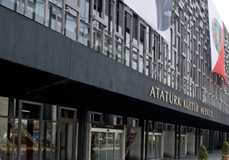Atatürk’s legacy / Istanbul
Building divisions
It’s 70 years since the death of Atatürk, founder of the Turkish Republic. But the fate of the Atatürk Cultural Centre has hung in the balance until recently, coming to symbolise the struggle between the secular state and the governing Islamist AK party. Then on page 40, we look at Atatürk’s role in modern Turkey.
The Atatürk Cultural Centre dominates the eastern side of Taksim Square, the heart of the European half of Istanbul. It was once one of the most important buildings in the city but today its doors are locked. The AKM, as it is known, is undergoing its first major renovation since it was completed in 1969, but it recently came close to being demolished. And the building’s backers still can’t relax – there is talk of political conspirators and circling developers, each with their own reasons for wanting it to be torn down. The AKM has none of the lavish Oriental grandeur that Istanbul is known for; instead it is a tribute to the modernist ideals that dominated Turkish society in the 1950s. Those ideals, and the legacy of Mustafa Kemal Atatürk – the founder of modern Turkey after whom the centre is named – are now under attack from Islamists, says one side of Turkish society.
It’s a fault line in Turkey that this year alone has seen fierce debates over the wearing of the hijab at the country’s universities, an attempt to outlaw the ruling Justice and Development (AK) Party in the courts on the grounds that it was breaking the secular constitution and an alleged plot by ultra secularists to overthrow the government foiled. So when news broke that the government planned to knock down the AKM, people took to the streets in protest to demand its protection. “The AKM is a very important building,” says Nur Serter, MP for the secular opposition Republican People’s Party (CHP), which was founded by Atatürk. “It is very symbolic as it reminds people of Atatürk’s legacy. Therefore the AK party was not comfortable with the AKM.”
Initial construction of the AKM began in 1946. Architect Rüknettin Güney wanted to build the city’s first opera house but a lack of finances put an end to the project. Ten years later, young architect Hayati Tabanlioglu returned to his homeland from Germany where he had obtained a doctorate in architecture. Hayati was assigned by the Ministry of Public Works, to redesign the project and had the idea of a cultural centre. However, poor finances continued to haunt the plans and the building was not completed until 1969. Less than a year later, a devastating fire broke out, destroying the building. It was rebuilt according to Hayati’s original plans but another seven years passed before it was reopened. Hayati’s son, Murat Tabanlioglu, is also an architect who runs a practice together with his wife, Melkan Gürsel.
We meet at the firm’s headquarters in Istanbul’s Pera district. “Hayati was a committed modernist. He belonged to the first generation of post-Second World War architects,” says Murat. He also designed Atatürk Airport and Galleria, a modern shopping mall in Istanbul. After Murat finished school in Vienna, father and son worked together until Hayati died in 1994.
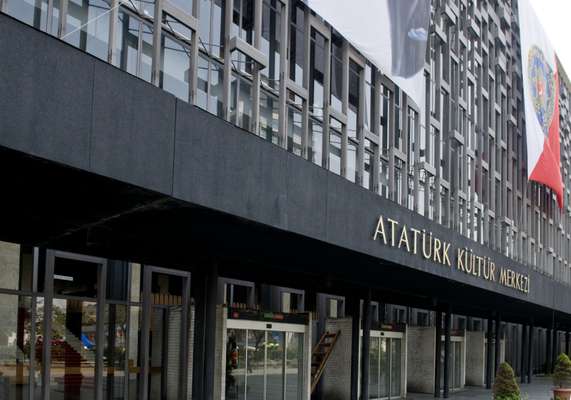
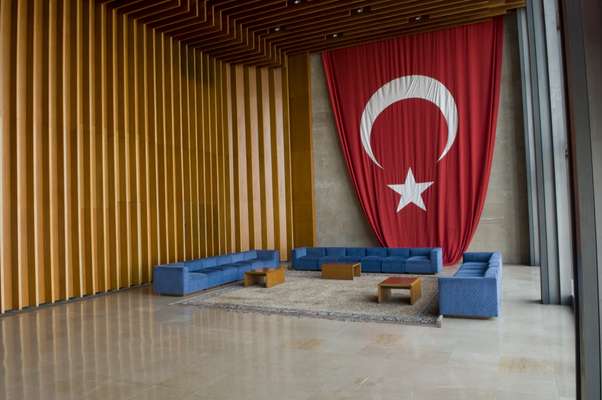

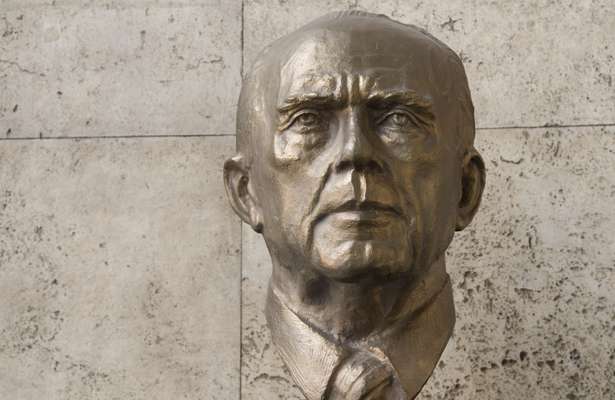
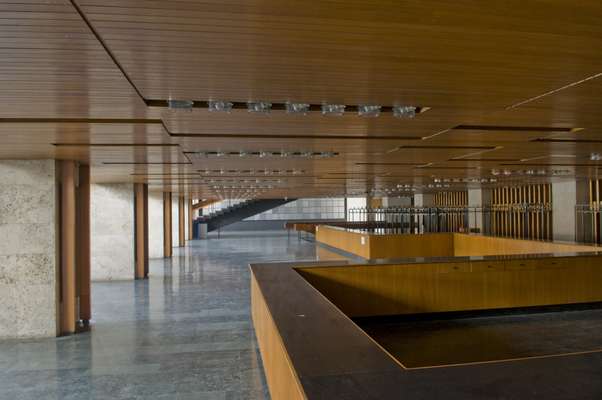

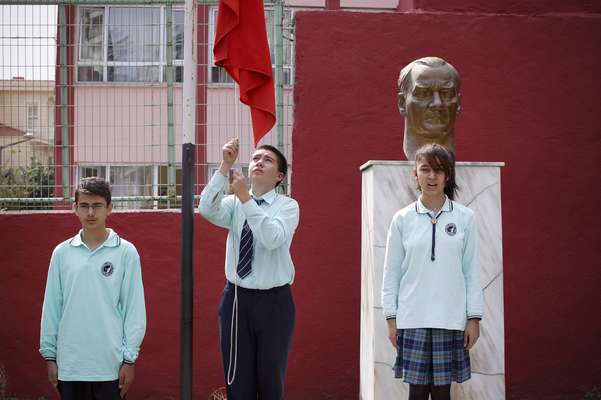
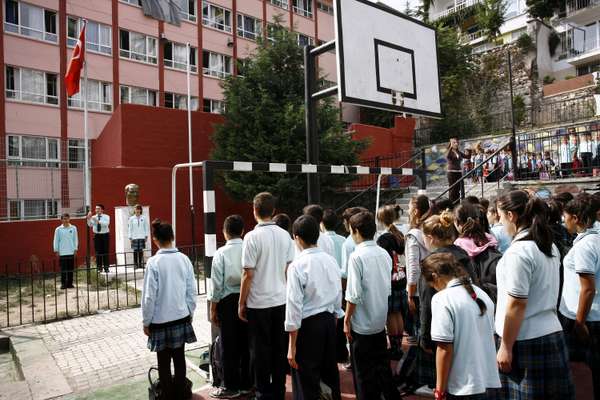
With its strategic location and distinctive exterior, the AKM came to symbolise the new Turkish republic and the modernisation of the country. During the Republican period, as it became known, fine arts were supposed to refine the masses, making them adapt to western values. Philharmonic orchestras were preferred to Turkish folk music and ballet to folk dances. Such state-sanctioned culture hoped to fill the void in public life previously occupied by Islam. But times have changed. Today the moderate Islamist AK party has successfully merged liberal market policies with social conservatism. Its populist blend appeals to the Turks on a wider scale than the AKM’s elitist ideals. And despite being designed as a place for people to congregate, the AKM was rarely open to the public. The centre was the stage for the Istanbul National Theatre, the opera and ballet as well as the National Symphony Orchestra. Ticket holders were allowed in a short while before performances and were ushered out swiftly once they were over.
Turkey also has an infatuation with things new and the dated AKM found little favour. The plumbing system is so old that during a parliamentary commission meeting Ertugrul Günay, Minister of Culture and Tourism, claimed theatregoers were distracted by flushing noises during performances. Inspired by the debate over the fate of the building, an exhibition held during the Istanbul biennial in 2007 was titled “Burn It or Not?”. Hürriyet newspaper columnist Hadi Uluengin described the AKM as “a freak of nature” and “a monument to disaster”. “It is the image of an ultra functionalist or even totalitarian architecture. It makes me think of buildings from Stalin’s time in eastern European countries,” he says.
So it didn’t seem surprising when in 2007 the Turkish parliament drafted a bill to demolish the AKM. In its place, a new shopping mall and car park would be built by 2010, when the city will be European Capital of Culture. A competition for a new centre was launched and €83m allocated to the project. But then the AKM’s supporters started emerging.
Several hundred artists, architects and intellectuals gathered outside the AKM for a series of colourful protests including opera performances and poetry readings. The demonstrations turned into a wider protest against the AK party. The protests grew until, in March this year, the Ministry of Culture and Tourism announced that the centre was to be closed down as of June but instead of being demolished it would now be renovated in time for 2010. Uluengin says the AK party had to back down:“The pseudo-republicans and the Kemalists generated an atmosphere where the demolition of the AKM would have been interpreted as a symbolic demolition of the secular and western conceptions of modern Turkey.” Murat says, “It was an aggressive example of how the conservative approach is out to destroy the history of modernity.”
To assure politicians of the AKM’s compatibility with today’s more open and democratic architectural aspirations, Murat’s firm is now working on the project pro bono. The blueprints stay true to the building’s original style while making it more accessible. It includes a rooftop restaurant and a return to Hayati’s ambition of creating a meeting place for Istanbul’s citizens – hopefully from both sides of the divide.
Face of a nation
Bedri Baykam’s gallery in central Istanbul is a shrine to revolutionary icons. As part of an exhibition that is celebrating the 40th anniversary of the radical protests of 1968 are portraits of Che Guevara and Deniz Gezmis – a Turkish leftist executed in the 1970s for plotting to overthrow the state. Yet all are dwarfed in Baykam’s pantheon of political heroes by Atatürk. “If I had to sum up what he has given this republic in two words, they would be freedom and democracy,” says Baykam, who often paints the “Father of the Turks”.
November 10 marks the 70th anniversary of Atatürk’s death. It will be commemorated with great solemnity in a country where citizens are taught to revere him with quasi-religious devotion. Cihangir primary school in Istanbul typifies how Turkish children are indoctrinated. A prominently placed portrait of Atatürk is headed by the inscription, Izindeyiz – meaning “We are following your footprint. ”Indeed, all over Turkey, Atatürk’s visage is inescapable. His portrait hangs in shops, workplaces and many homes. His statue stands in the public squares of towns and cities while his face is imprinted on coins and banknotes. Yet his most committed followers feel besieged. Turkey’s secular constitution is supposed to keep Islam, the religious faith of 99 per cent of the population, subservient to the state. But some of its tenets are being challenged by the neo-Islamist AK, which wants a more prominent place for religion.
Baykam is an activist in the Republican People’s Party, founded by Atatürk, and member of the Kemalist Thought Association, an organisation dedicated to upholding his secularist vision. “The AK try to depict Atatürk as an anti-democratic fascist leader who forced Turkey into westernisation and oppressed religion,” says Baykam. Some of Atatürk’s keenest adherents face trial after prosecutors alleged that a secular nationalist group known as Ergenekon conspired to oust the AK in a military coup. Among those recently arrested was Kemalist Thought Association chairman, Sener Eruygur, a retired army general. Baykam says the current state of affairs would have dismayed Atatürk. It is a sentiment represented in the portrait “Thank You, Turkey”, which sets Atatürk against a collage of contemporary figures including Erdogan, his ally, President Abdullah Gül, and their wives, both wearing Islamic headscarves. “This is Atatürk asking today’s Turks, is this what I have left you?” Baykam says. “You have gone 200 years backwards, if not to the Middle Ages.”
Father of the Turks
Mustafa Kemal Atatürk’s face adorns all public buildings in Turkey and his portrait greets visitors in almost every shop and in many homes. He is the founder of the modern Turkish Republic and is highly respected by Turks. After leading the Turkish forces to victory in what is known as the Turkish War of Independence in 1922, he went on to create a secular, democratic nation state along European lines from the ruins of the Ottoman Empire. The principles on which he built the new nation are referred to as Kemalism. It is forbidden by law to insult Atatürk or his legacy, a law that is sometimes used by the country’s courts to silence critics of the strictly secular order. Atatürk died on 10 November 1938. Every year on that date at 09.05, Turkey comes to a standstill for one minute’s silence.

